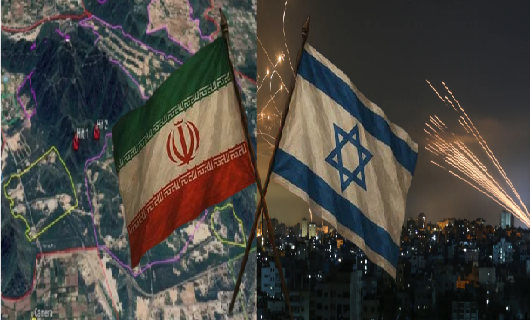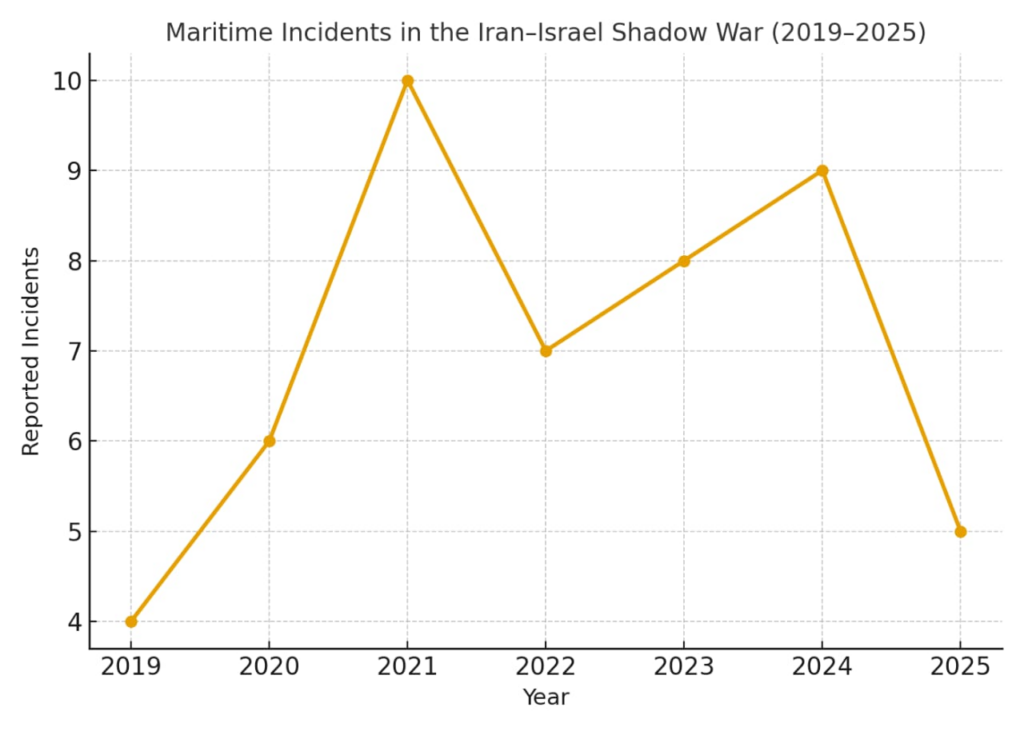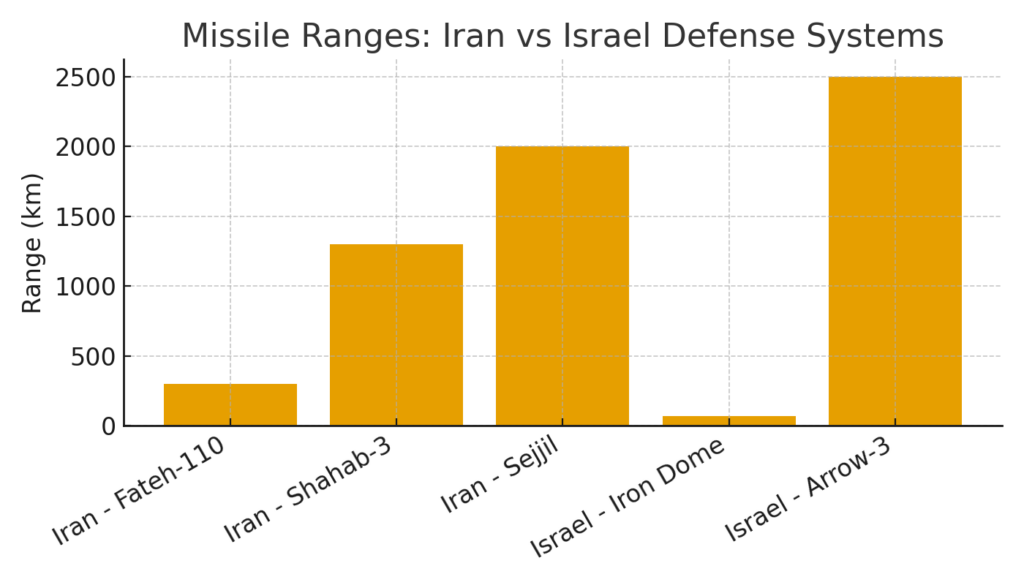
- The Iran-Israel confrontation does not often manifest as actual combat. Instead, it is buried in the undercurrents of covert activities and asymmetric approaches.
- Since 2019, Israel and Iran have engaged in a cycle of escalatory attacks against merchant shipping in the Gulf of Oman and Eastern Mediterranean.
- One of the biggest battles so far in the shadow war is through cyber operations. Israel repeatedly attacked nuclear installations in Iran, while Iran retaliated with cyber attacks on Israel’s water system, financial system, and media outlets.
- Policymakers’ ultimate challenge is preventing a shadow conflict from escalating into a full-scale regional war.
Introduction
The Iran-Israel confrontation is one of longstanding nature and has been gradually morphing into a “shadow war” – a multi-dimensional confrontation occurring through proxy militias, cyber actions, sabotage or sabotage operations, maritime detentions, and intelligence activities. Unlike conventional wars, the Iran-Israel confrontation does not often manifest as actual combat. Instead, it is buried in the undercurrents of covert activities and asymmetric approaches. This article serves to think tanks of the shadow war that maps trends of open-source intelligence (OSINT) in the military, maritime, cyber and nuclear domains.
Historical Origins of the Conflict
The Iran–Israel shadow war has its origins in the Iranian Revolution in 1979, cementing Iran’s status as a sworn enemy of Israel. Islamic Iran considered it a formal policy “to resist” what it saw as Zionist aggression, while Israel viewed Iran’s intentions to build nuclear weapons as an existential threat. The dark nature of the war revealed itself with such incidents as the 2010 Stuxnet cyberattack on Iranian uranium enrichment and the assassinations of Iranian nuclear scientists. In due course, the war spilt over to other fronts.
Proxy Battlefields
The shadow war between Israel and Iran shows its real face through Iran’s allies across the Middle East. These groups act as extensions of Iran’s power, letting it strike without direct fights. In Lebanon, Hezbollah stands out as Israel’s top short-term danger. This Shiite militia, backed by Iran since the 1980s, holds an arsenal of about 150,000 rockets and missiles. Many point toward Israeli cities. Hezbollah amassed this cache over the years, with Iran’s assistance in training and provisions. One barrage could overwhelm Israel’s defence and strike deep within the country.
Israel strikes back fiercely in Syria. Its air force has targeted more than 1,000 sites since 2017. The targets include Islamic Revolutionary Guard Corps bases, weapon depots, and Iranian loyalists’ fighters. The IRGC is Iran’s top military division and employs Syria as a transit route to equip Hezbollah. Israel moves to prevent weapons from finding their way to Lebanon.
For instance, the Israeli aircraft bombed a convoy with sophisticated drones headed for Hezbollah late in 2023. Such precautions contain Iran’s reach but with heightened risks of broader conflicts. Iraq is an important transit point for Iran’s activities. Iranian troops and militias smuggle material across its borders. Units such as Kata’ib Hezbollah fire rockets at American bases there, usually to put pressure on Israel indirectly. This configuration allows Iran to send weapons north to Syria and east to other destinations without taking direct routes.
Further south, Yemeni Houthi rebels enter the mix. They are supplied with missiles and drones by Iran. The Houthis now tie their attacks to the struggle for Palestinians and win broader support. They are attacking ships in the Red Sea, an important path for international commerce. Each incident since late 2023 has impacted more than 100 different ships, leading to the forced rerouting of ships and increased costs. One of the drone attacks on a ship from the Houthis movement in January 2024 led to the purported destruction of a U.S.-owned cargo ship, showing their expanding operational range.
| In 2021, reports indicated that China had illegally supplied kamikaze drones to Iran, which were allegedly transferred further to the Houthis and Hezbollah. In the following years, the Houthis employed these drones in attacks, including a strike on Saudi Arabia’s oil refinery in Jeddah, believed to have been facilitated by Iran. More recently, the Houthis have used similar kamikaze drones in their assaults on ships near Yemen. In October 2024, Hezbollah also deployed UAVs in an attack against Israeli Defence Forces in Binyamina, Israel. |
Open-source intelligence makes it possible to monitor all of this. Techniques such as satellite imagery from companies like Maxar detect truck convoys crossing international boundaries. Databases by organisations like the Institute for National Security Studies record types of weapons. They have charted Iran’s supply of precision-guided missiles to Hezbollah and drones to the Houthis. For example, 2022 imagery captured an Iranian cargo aircraft arriving in Yemen with pieces of missiles. Experts maintain that this information confirms Iran’s involvement in financing proxy attacks, without the need for clandestine spies. It paints a clear image of the size of the hidden war.
The Maritime Dimension
An important, but less immediately evident, theatre of military conflict also exists in the maritime realm. Since 2019, Israel and Iran have engaged in a cycle of escalatory attacks against merchant shipping in the Gulf of Oman and Eastern Mediterranean. Iranian oil tankers have been attacked to interdict sanctions evasion, and Israeli vessels have been targeted with explosive drones. Monitoring suspicious maritime movements and unusual vessel activity, relying on the AIS system, has enabled and facilitated OSINT analysis.

Cyber and Intelligence Dimensions
One of the biggest battles so far in the shadow war is through cyber operations. Israel’s Unit 8200 repeatedly attacked nuclear installations in Iran, while Iran retaliated with cyber attacks on Israel’s water system, financial system, and media outlets. Past and recent threat intelligence reports (Check Point, FireEye) mention enhancements in continuing operations from Lead Iranian APT actors such as ‘Charming Kitten,’ while Israeli defences are quite advanced but are forever operating at full capacity.

Nuclear and Missile Dimension
Iran’s continued development of uranium enrichment remains a worrisome factor for Israel, as it has vowed to prevent Tehran from achieving weapons potential. Meanwhile, the nation has enhanced its capability in missiles, from short-range ballistic missiles (SRBMs) up to longer-range missiles like the Shahab-3, capable of striking Israel. In response, Israel counts on layered defence missile systems: Iron Dome, David’s Sling, and the Arrow program. Open source intelligence (OSINT) literature provides comparative perspectives on databases of missile tracking systems.

The Role of the US and Regional Implications
The United States is attempting to steer clear of contributing to the heightening of wars in the Persian Gulf while providing security for Israel. U.S. Navy patrols have interrupted several Iranian attacks. The Gulf Cooperation Council fears the conflict will impact their security and commerce, although they are solidly in Israel’s corner against Iran because of Iran’s long-standing threats. Key sea lanes such as the Strait of Hormuz are vital, with much of the oil consumed globally passing through this strait; if this is disrupted, it could result in a fuel price spike. Israel’s extended struggle with Iran is all about countering Iranian proxy forces, particularly Hezbollah, who directly threaten it.
Israel’s ongoing battle has seen dozens of strikes against Iranian targets inside Syria in an effort to inhibit deliveries of arms to Hezbollah. Iran’s efforts have also been bolstered by Shia militias in Iraq and Yemen, further complicating the picture in the region. The intelligence landscape of Iran’s backing of proxies has become increasingly detailed over time. Tensions have been building against this background since the Shah of Iran was overthrown in a series of cyberattacks and assassinations of Iranian scientists involved in nuclear activities. The illegal struggle continues in the shadow of a covert war, and the threat of escalation is always imminent.
Outlook and Conclusion
The Iran-Israel shadow war does not seem to be tapering off. Possible flashpoints are growing in Lebanon, direct Israeli strikes on Iran’s nuclear facilities, or cyberattacks against strategic critical infrastructure. OSINT will stay the primary form of uncovering covert activities and shaping global narratives. Policymakers’ ultimate challenge is preventing a shadow conflict from escalating into a full-scale regional war.
References
- International Institute for Strategic Studies (IISS), Middle East Security Report 2024.
- CSIS Missile Defence Project Database.
- Check Point Software Technologies – Annual Cyber Threat Report 2024.
- United Nations Panel of Experts on Iran, Maritime Incident Reports (2019–2025).
- Carnegie Endowment for International Peace, ‘Iran’s Strategic Posture’ (2023).
Daljeet Singh holds a BTech in Computer Science and is currently pursuing an MA in Political Science. His interests range across geopolitics, international relations, and technology. An avid reader and writer, he is passionate about exploring the intersections of these fields. Views expressed are the author’s own.
